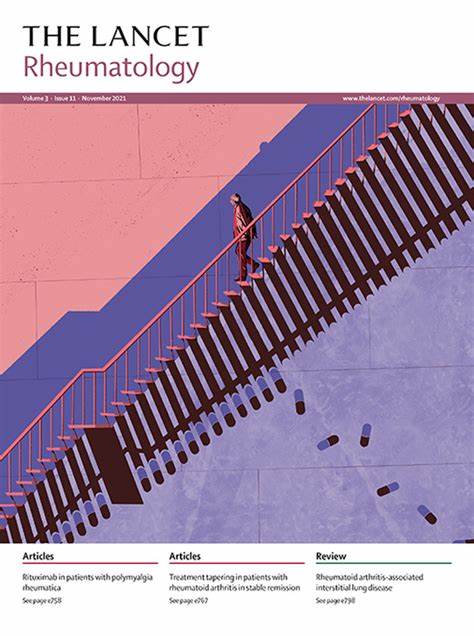预测系统性硬化症相关间质性肺疾病进展患者后续进展的风险:一项多中心观察队列研究
IF 16.4
1区 医学
Q1 RHEUMATOLOGY
引用次数: 0
摘要
背景:在系统性硬化症患者中,通常的做法是治疗已经发生进展的间质性肺疾病(ILD)。我们试图澄清观察到的系统性硬化症相关ILD的进展是否会带来后续进展的风险。方法:在这项多中心观察性队列研究中,基于前瞻性收集数据的分析,我们纳入了诊断时年龄在18岁或以上的系统性硬化症相关ILD患者,这些患者符合2013年美国风湿病学会-欧洲风湿病联盟协会系统性硬化症分类标准。主要队列(诊断于2001年1月至2019年12月)在挪威奥斯陆大学医院风湿病科和瑞士苏黎世大学医院风湿病科连续随访4年。我们采用了四种ILD进展定义:主要定义是强迫肺活量(FVC)下降5%或以上,次要定义包括FVC下降10%或以上,进行性肺纤维化(PPF)和进行性纤维化ILD (PF-ILD)。我们在第一次(访视1)之后的每次年度访视中应用这些定义。我们在一个充实的队列中验证了我们的发现,该队列包括来自主要队列的系统性硬化症相关ILD患者,病程短于3年,以及2003年1月至2019年9月期间从美国密歇根州安娜堡市密歇根大学风湿病学系诊断的患者。应用多变量logistic回归分析预测ILD进展及其对死亡率的影响。在这项研究中没有有生活经验的人参与。结果:来自主要队列的231例系统性硬化症相关ILD患者(平均年龄48.0岁[SD 14.6], 176例[76%]女性,55例[24%]男性)中,71例(31%)的FVC在第1次至第2次就诊期间下降5%或以上,38例(16%)FVC下降10%或以上,39例(17%)为PPF, 89例(39%)为PF-ILD。在多变量logistic回归分析中,校正了进行性系统性硬化症相关ILD和免疫抑制治疗的危险因素,我们发现,从第一次就诊到第二次就诊,ILD进展(以FVC下降5%或更多定义)降低了从第二次就诊到第三次就诊进一步进展的风险(优势比[or] 0.28 [95% CI 0.12 - 0.63];p= 0.002),使用其他定义(FVC下降≥10%:0.57[0.16 -1·99;p = 0·38);Ppf: 0.93 [0.39 ~ 2.22;p = 0·88);PF-ILD: 0.69 [0.35 - 1.36];p = 0·28])。使用进展的主要定义,我们在系统性硬化症相关ILD队列中发现了相同的结果,其中121例患者中有41例(34%)的进展定义为FVC下降5%或更多(or 0.22 [95% CI 0.06 - 0.87];p = 0·031)。植被覆盖度下降5%或以上与死亡率显著相关(危险比1.66 [95% CI 1.05 - 2.62];P =0·030),经其他危险因素校正。解释:系统性硬化症相关ILD进展不能预测下一次年度随访时ILD的进一步进展,即使在丰富的人群中也是如此,但进展与死亡率相关。这些结果对临床实践具有启示意义,因为它们支持治疗策略的范式转变,倡导在有进展风险的患者中开始治疗。需要进一步的研究来证实这些发现。资金:没有。翻译:关于摘要的德语和挪威语翻译,请参见补充材料部分。本文章由计算机程序翻译,如有差异,请以英文原文为准。
Predicting the risk of subsequent progression in patients with systemic sclerosis-associated interstitial lung disease with progression: a multicentre observational cohort study
Background
In patients with systemic sclerosis, it is common practice to treat interstitial lung disease (ILD) in patients in whom progression has already occurred. We sought to clarify whether observed progression of systemic sclerosis-associated ILD confers risk for subsequent progression.
Methods
In this multicentre observational cohort study, based on an analysis of prospectively collected data, we included patients with systemic sclerosis-associated ILD aged 18 years or older at diagnosis, who fulfilled the 2013 American College of Rheumatology–European Association of Alliances in Rheumatology systemic sclerosis classification criteria. The main cohort (diagnosed between January 2001 and December 2019) was consecutively followed up annually over 4 years at the Department of Rheumatology at the Oslo University Hospital, Norway, and the Department of Rheumatology at the University Hospital Zurich, Switzerland. We applied four definitions of ILD progression: the primary definition was forced vital capacity (FVC) decline of 5% or more, and secondary definitions included FVC decline of 10% or more, progressive pulmonary fibrosis (PPF), and progressive fibrosing ILD (PF-ILD). We applied these definitions at each annual visit after the first (visit 1). We validated our findings in an enriched cohort that included patients from the main cohort with systemic sclerosis-associated ILD and short disease duration of less than 3 years along with patients diagnosed between January 2003 and September 2019 from the Division of Rheumatology, University of Michigan, Ann Arbor, MI, USA. Multivariable logistic regression analyses were applied to predict ILD progression and its effect on mortality. There was no involvement of people with lived experience in this study.
Findings
Of 231 patients with systemic sclerosis-associated ILD from the main cohort (mean age 48·0 years [SD 14·6], 176 [76%] female and 55 [24%] male), 71 (31%) had ILD progression as defined by an FVC decline of 5% or more between visit 1 and visit 2, 38 (16%) as defined by an FVC decline of 10% or more, 39 (17%) as defined by PPF, and 89 (39%) defined by PF-ILD. In multivariable logistic regression analyses, adjusted for risk factors for progressive systemic sclerosis-associated ILD and immunosuppressive treatment, we found that ILD progression, defined by FVC decline of 5% or more, from visit 1 to visit 2 reduced the risk for further progression from visit 2 to visit 3 (odds ratio [OR] 0·28 [95% CI 0·12–0·63]; p=0·002) and that there was no risk for subsequent progression using the other definitions (FVC decline of ≥10%: 0·57 [0·16–1·99; p=0·38]; PPF: 0·93 [0·39–2·22; p=0·88]; and PF-ILD: 0·69 [0·35–1·36]; p=0·28]). Using the primary definition of progression, we found the same results in the enriched systemic sclerosis-associated ILD cohort, wherein 41 (34%) of 121 patients had progression defined by an FVC decline of 5% or more (OR 0·22 [95% CI 0·06–0·87]; p=0·031). FVC decline of 5% or more was significantly associated with mortality (hazard ratio 1·66 [95% CI 1·05–2·62]; p=0·030) adjusted for other risk factors.
Interpretation
Systemic sclerosis-associated ILD progression does not predict further ILD progression at the next annual follow-up visit, even in an enriched population, but progression was associated with mortality. These results have implications for clinical practice because they support a paradigm shift in treatment strategy, advocating for initiating therapy in patients at risk of progression. Further research is needed to confirm these findings.
Funding
None.
Translations
For the German and Norwegian translations of the abstract see Supplementary Materials section.
求助全文
通过发布文献求助,成功后即可免费获取论文全文。
去求助
来源期刊

Lancet Rheumatology
RHEUMATOLOGY-
CiteScore
34.70
自引率
3.10%
发文量
279
期刊介绍:
The Lancet Rheumatology, an independent journal, is dedicated to publishing content relevant to rheumatology specialists worldwide. It focuses on studies that advance clinical practice, challenge existing norms, and advocate for changes in health policy. The journal covers clinical research, particularly clinical trials, expert reviews, and thought-provoking commentary on the diagnosis, classification, management, and prevention of rheumatic diseases, including arthritis, musculoskeletal disorders, connective tissue diseases, and immune system disorders. Additionally, it publishes high-quality translational studies supported by robust clinical data, prioritizing those that identify potential new therapeutic targets, advance precision medicine efforts, or directly contribute to future clinical trials.
With its strong clinical orientation, The Lancet Rheumatology serves as an independent voice for the rheumatology community, advocating strongly for the enhancement of patients' lives affected by rheumatic diseases worldwide.
 求助内容:
求助内容: 应助结果提醒方式:
应助结果提醒方式:


